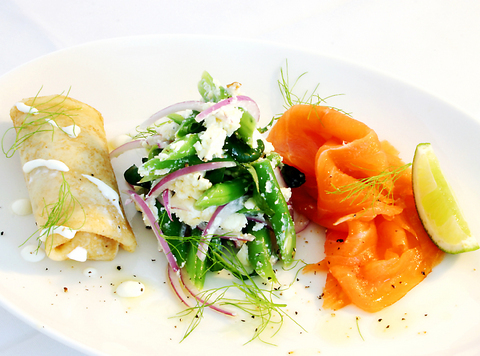Home to the renowned Paris 1930, touted as one of Taipei's top French restaurants by several industry guides, The Landis Taipei also houses some other restaurants that haven't had the same exposure but are nevertheless worth a visit, and will not leave such a huge dent in the wallet.
La Brasserie, which serves traditional French cuisine made by Chef Thomas Seiler, is currently host to chef Bert Lozey, who has prepared a West Australian menu that ends this weekend.
Exactly what constitutes Australian cuisine is up for debate as the country has been influenced by waves of immigration from many parts of the world and has a vast climate range, which produces a plethora of agricultural produce. Kangaroo burgers, witchetty grubs and vegemite are undoubtedly Aussie tucker, but cured salmon, warm Brie crepe with French beans and horseradish sauce does not immediately bring to mind the continent.

PHOTO COURTESY O F THE LANDIS
But the salmon is from Tasmania and the pairing of horseradish and fish is not an Anglo-Saxon tradition. However, it does mirror the Japanese duet of Wasabi, also a member of the mustard family, and sashimi.
Fusion, experimentation and fresh produce combine to form some exciting dishes. Lozey's mussel, tomato, fennel and saffron "Pot au Feu," which includes a crispy fish cake, packs a punch by merging Thai flavors with European character.
Roast lamb rib eye, with braised lettuce and baked white polenta, a ground corn dish -- once regarded as a staple in Italy and now transformed into a fashionable accompaniment -- is rounded off with Shiraz gravy. The prime cut of lamb had a slightly sweet, mild taste and was well complimented by the velvet Shiraz gravy which retained the qualities of the Australian wine.
There is a mismatch at the Brasserie, albeit a pleasant one. The Australian menu is contemporary, crosses boundaries and melds together divergent flavors, but the decoration, with brown leather upholstery, brass rails and wood paneling creates a warm, nostalgic atmosphere.

June 2 to June 8 Taiwan’s woodcutters believe that if they see even one speck of red in their cooked rice, no matter how small, an accident is going to happen. Peng Chin-tian (彭錦田) swears that this has proven to be true at every stop during his decades-long career in the logging industry. Along with mining, timber harvesting was once considered the most dangerous profession in Taiwan. Not only were mishaps common during all stages of processing, it was difficult to transport the injured to get medical treatment. Many died during the arduous journey. Peng recounts some of his accidents in

“Why does Taiwan identity decline?”a group of researchers lead by University of Nevada political scientist Austin Wang (王宏恩) asked in a recent paper. After all, it is not difficult to explain the rise in Taiwanese identity after the early 1990s. But no model predicted its decline during the 2016-2018 period, they say. After testing various alternative explanations, Wang et al argue that the fall-off in Taiwanese identity during that period is related to voter hedging based on the performance of the Democratic Progressive Party (DPP). Since the DPP is perceived as the guardian of Taiwan identity, when it performs well,

The Taiwan People’s Party (TPP) on May 18 held a rally in Taichung to mark the anniversary of President William Lai’s (賴清德) inauguration on May 20. The title of the rally could be loosely translated to “May 18 recall fraudulent goods” (518退貨ㄌㄨㄚˋ!). Unlike in English, where the terms are the same, “recall” (退貨) in this context refers to product recalls due to damaged, defective or fraudulent merchandise, not the political recalls (罷免) currently dominating the headlines. I attended the rally to determine if the impression was correct that the TPP under party Chairman Huang Kuo-Chang (黃國昌) had little of a

At Computex 2025, Nvidia CEO Jensen Huang (黃仁勳) urged the government to subsidize AI. “All schools in Taiwan must integrate AI into their curricula,” he declared. A few months earlier, he said, “If I were a student today, I’d immediately start using tools like ChatGPT, Gemini Pro and Grok to learn, write and accelerate my thinking.” Huang sees the AI-bullet train leaving the station. And as one of its drivers, he’s worried about youth not getting on board — bad for their careers, and bad for his workforce. As a semiconductor supply-chain powerhouse and AI hub wannabe, Taiwan is seeing